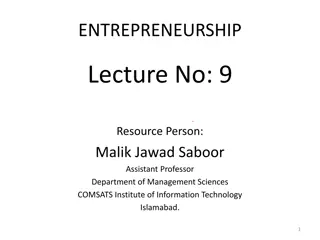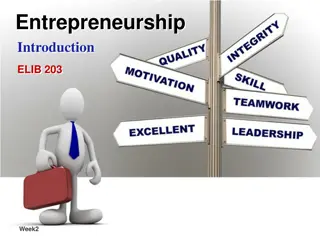
Key Elements of Entrepreneurship Process
Explore the definition of an entrepreneur according to Joseph A. Schumpeter, emphasizing innovation, risk-taking, vision, and organizing skills. Learn about the various stages in the entrepreneurial process, from idea generation to market research and completion of promotional formalities.
Download Presentation

Please find below an Image/Link to download the presentation.
The content on the website is provided AS IS for your information and personal use only. It may not be sold, licensed, or shared on other websites without obtaining consent from the author. If you encounter any issues during the download, it is possible that the publisher has removed the file from their server.
You are allowed to download the files provided on this website for personal or commercial use, subject to the condition that they are used lawfully. All files are the property of their respective owners.
The content on the website is provided AS IS for your information and personal use only. It may not be sold, licensed, or shared on other websites without obtaining consent from the author.
E N D
Presentation Transcript
WHO IS AN ENTREPRENEUR
DEFINITION Joseph A. Schumpeter defines entrepreneur as a person one who innovates, raises money assembles inputs, chooses managers and sets the organization going with his ability to identify them. Innovation could occur through The introduction of a new quality in a product A new product itself Discovery of a fresh demand and a fresh source of supply and By changes in the organization and management
Schumpeter adds that in a developing economy an entrepreneur is a person who starts an industry, it could either be old or new, undertakes risk, bears uncertainties and also performs the managerial functions of decision-making and coordination and puts the new process based on analogical research into operation.
Thus we can say that though Entrepreneurship may be defined in various ways, but the following four elements involved in it are important: Innovation- That means they should bring innovation to the product or service or new ways of using the product or service. Risk taking-They should be risk takers, it means they should have the ability to deal with some degree of uncertainty Vision They should have the ability to foresee the state of things through their intelligence. Organizing skills.-They must have the ability to deal with larger set of things and people.
VARIOUS STAGES IN THE ENTREPRENEURIAL PROCESS Idea generation and scanning for the best suitable idea This is the first step in any entrepreneurship process. Idea generation involves deciding about the selection of a new project. The project could involve something relating to a product or service which is already there or it could be a completely new idea. For example if we talk about bringing innovation to an existing line of product then we could talk about shampoo industry .In the 1980s a southern based Company started distributing shampoos in sachets which concept was a very new one.
Product analysis and Market Research Before entering into any entrepreneurship venture it is very important to make a proper analysis of the new product. For this purpose it is very important to conduct market research.Corporates at times uses the tool of Market Research to relaunch an existing product Determination of form of ownership/ organization
Completion of promotional formalities Promotional formalities involve deciding about the name of the Company, name of the promoters, place at which registered office will be situated Raising necessary funds Procurement of men,machine and material Undertaking the business operations Managing the business operation
INTRAPRENEUR Intrapreneur is an employee who works in a large corporation and with the support of the top management takes direct responsibility for turning his idea into a profitable finished product through assertive risk-taking and innovation. The intrapreneur has the same characteristics as that of the entrepreneur i.e. conviction, passion and drive. The Intrapreneur can be successful when the company becomes supportive and gives him a free hand to run his project. The Post-it note by 3M,Facebook s like button and Sony Play Station are examples of Intrapreneurship.Spencer Silver developed the Post-It note while working with the 3M.






















